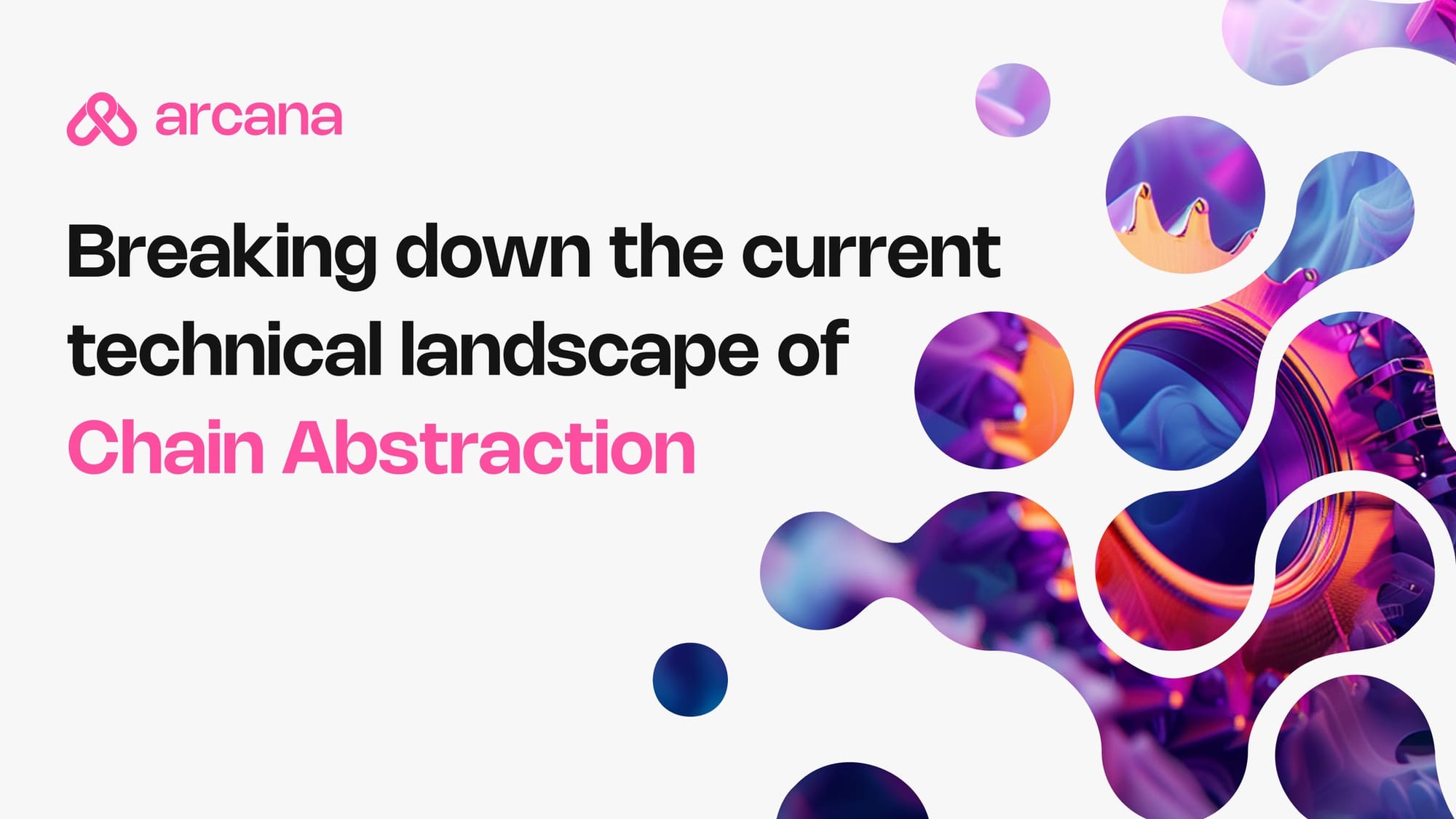Breaking down the current technical landscape of Chain Abstraction
In the rapidly evolving landscape of Web3, the concept of chain abstraction is emerging as a groundbreaking innovation poised to transform how users interact with blockchain networks.

In the rapidly evolving landscape of Web3, the concept of chain abstraction is emerging as a groundbreaking innovation poised to transform how users interact with blockchain networks. Chain abstraction refers to the ability to seamlessly use any decentralized application (dApp) on any blockchain, with any token, without the need for traditional bridging methods. This approach is set to revolutionize the ecosystem by making blockchain technology more accessible, efficient, and user-friendly.
The crypto market's current reliance on bridging protocols, which allow users to transfer assets between different blockchains, has been significant. The top 5 bridges process around USD 2 Billion every month. While bridges have played a crucial role in fostering interoperability and liquidity across chains, they come with their own set of challenges. These include security latency, vulnerabilities, high transaction fees, and complex user experiences. Despite their importance, these issues underscore the urgent need for a more streamlined and more importantly, a less complex solution for nonnative users.
Enter chain abstraction: a paradigm shift that aims to address the limitations of traditional bridges. This exciting development is being spearheaded by several innovative companies, disrupting the bridge market and setting new standards for cross-chain interoperability, inspiring hope for a more accessible and efficient blockchain future.
In this blog, we will explore the various strategies and technologies employed to achieve chain abstraction, examine how they overcome the challenges associated with traditional bridging, and discuss the profound benefits they bring to the entire Web3 ecosystem. Join us as we delve into the future of blockchain interoperability.
Approaches to solving Chain Abstraction
Chain abstraction is a multifaceted challenge that has sparked a range of innovative solutions within the Web3 ecosystem. From cross-chain protocols to Layer 2 solutions, middleware, intent-based protocols, and universal settlement layers, each approach offers unique advantages and addresses specific pain points in achieving seamless blockchain interoperability. This section will delve into these diverse strategies, their pros and cons, and how different projects and technologies tackle the complexities of chain abstraction to create a more cohesive and user-friendly decentralized landscape.
Approach #1: Cross-Chain Protocols
Cross-chain protocols are designed to enable seamless interaction and transfer of assets between different blockchain networks, effectively creating a unified multi-chain ecosystem. These protocols establish a common framework that facilitates interoperability, often using Externally Owned Accounts (EOAs) and specialized smart contracts. By leveraging technologies like atomic swaps, relays, and bridges, cross-chain protocols ensure that transactions can be securely executed across disparate blockchains without requiring a centralized intermediary. This approach enhances scalability and efficiency and allows developers to build decentralized applications (dApps) that can operate across multiple chains, thereby expanding their reach and utility. Cross-chain protocols include NEAR Protocol, which uses the Rainbow Bridge for Ethereum interoperability, and Cosmos, which employs the Inter-Blockchain Communication (IBC) protocol to connect various independent blockchains.
Pros:
- Interoperability: Enables seamless asset transfers and interactions between different blockchains.
- Scalability: Often incorporates mechanisms like sharding to handle high transaction volumes
- Developer Flexibility: Allows developers to build applications that interact with multiple blockchains.
Cons:
- Complexity: Implementing and maintaining cross-chain protocols can be complex.
- Security Risks: Cross-chain interactions can introduce additional security vulnerabilities.
Approach #2: Layer 2 solutions
Layer 2 solutions are secondary frameworks or protocols built on top of existing blockchain networks, primarily designed to enhance scalability and reduce transaction fees. They work by processing transactions off the main chain (Layer 1), thereby alleviating the load on the base layer while still relying on its security for finality. These solutions utilize techniques such as rollups (including zk-rollups) and state channels. ZK-rollups, for instance, bundle multiple transactions off-chain and generate a cryptographic proof (zero-knowledge proof) that is then submitted to the Ethereum main chain for verification, ensuring security and integrity. However, Layer 2 solutions are typically limited to their parent chains, meaning they enhance scalability and efficiency within a single blockchain ecosystem but do not inherently support a wide range of cross-chain interactions. Examples of project building are the L2s like Arbitrum and Polygon’s aggregated layer.
Pros:
- Scalability: Significantly increases transaction throughput and reduces fees.
- Speed: Faster transaction processing times compared to Layer 1.
- Cost Efficiency: Lower transaction costs make it more accessible for users.
Cons:
- Complexity for Developers: Requires additional development effort to integrate L2 solutions with existing dApps.
- Security Dependencies: Relies on the security of the underlying Layer 1 blockchain.
- Not truly Multichain: L2s are primarily limited to their parent chain
Approach #3: Using middleware solutions
Middleware solutions in blockchain serve as intermediary layers that facilitate communication, data exchange, and interoperability between blockchains. These solutions provide essential services such as decentralized oracles, cross-chain messaging, and bridging capabilities, thereby abstracting the complexities of interacting with multiple chains.
For instance, Chainlink is a decentralized oracle network that allows smart contracts on various blockchains to securely interact with real-world data, events, and traditional payment systems. By providing reliable, tamper-proof data feeds, Chainlink enables complex smart contract functionalities beyond individual blockchains' capabilities.
Hyperlane, on the other hand, is a cross-chain messaging protocol that facilitates seamless communication between different blockchain networks. It enables developers to build applications that can interact with multiple chains, sending messages and data across them securely and efficiently. Hyperlane’s infrastructure abstracts the intricacies of cross-chain communication, making it easier for developers to build interoperable applications.
Pros:
- Standardization: Provides standardized protocols for data exchange and interoperability. These protocols have been doing this for a long time and have an idea of scale, a large user base, and desired distribution to be genuinely multichain.
- Flexibility: They are already used across multiple blockchain networks for their usecase. Transactions are an added usecase built on top of their current usecase.
- Enhanced Functionality: Offers additional features like decentralized oracles and cross-chain messaging.
Cons
- Added Complexity: Introducing middleware can add an extra layer of complexity
- Latency: This can introduce delays in communication between different blockchains.
- Modularity: These solutions may not be very modular. An L2 protocol can have multiple middleware providers to reduce dependency on a single point of failure, unlike middleware such as Chainlink, which won't use its competitor Hyperlane if its services fail at any given time.
Approach #4: Intent-based protocols
Intent-based protocols simplify cross-chain interactions by abstracting the complexities of executing transactions across multiple blockchains. Instead of manually handling each transaction step, users express their intent (what they want to achieve), and the protocol automates the execution, ensuring the desired outcome is achieved seamlessly.
For example, Across is an intent-based protocol that enables users to perform actions like swapping tokens or moving assets between different chains without understanding the intricate details of each blockchain involved. When a user expresses an intent, such as transferring an asset from Ethereum to Polygon, Across takes care of the entire process, including finding the best route, handling the necessary transactions, and ensuring security and efficiency.
These protocols often utilize advanced algorithms and smart contracts to manage the underlying operations. They can aggregate liquidity from multiple sources, optimize transaction paths, and provide real-time execution of complex cross-chain transactions using relayers. By doing so, intent-based protocols offer a more user-friendly experience, reducing the barriers to interacting with multiple blockchain networks and enabling a more integrated and efficient decentralized ecosystem.
Pros:
- User-Friendly: Simplifies the user experience by abstracting complex processes.
- Automation: Automates cross-chain interactions, reducing manual effort.
- Seamless Interactions: Provides a smooth and intuitive user experience.
Cons:
- Complex Implementation: Developing and maintaining intent-based protocols can be challenging.
- Limited Control: Users may have less control over specific transaction details
Approach #5: Universal Settlement Layer
The universal settlement layer is a framework designed to provide a unified and consistent mechanism for settling transactions across multiple blockchain networks. It integrates Smart Contract Wallets (SCWs) on various chains and leverages interoperable frameworks like the Cosmos SDK to ensure seamless and secure transaction processing. Particle Network exemplifies this approach by integrating SCWs on multiple chains. This setup allows Particle Network to offer a universal settlement mechanism, enabling users to perform transactions across different chains.
Pros
- Unified Framework: Provides a consistent settlement layer across multiple blockchains.
- Security: Benefits from the robust security features of the Cosmos SDK.
- Flexibility: Allows for a wide range of applications to be built on top of it.
Cons
- Implementation Complexity: Building and integrating a universal settlement layer can be complex, leading to slower development speeds.
- Resource Intensive: This may require significant computational resources. Thus becoming a costlier option for end users.
Conclusion
Chain abstraction represents a significant leap forward in enhancing the user experience within the blockchain ecosystem. By abstracting the complexities of interacting with multiple blockchains, users can focus on the value and utility of decentralized applications without being bogged down by technical details. This seamless interaction paves the way for broader adoption, as users can effortlessly move assets, perform transactions, and engage with dApps across various chains from a single, unified interface.
These advancements in chain abstraction are achieved through various innovative approaches discussed above. Each approach offers unique benefits and addresses different challenges, collectively contributing to a more interconnected and efficient blockchain environment. As life comes full circle for Web3, we witness a fascinating evolution: we initially built chains for decentralization, then specialized chains for specific use cases, and now we are moving towards unifying these chains, much like the Web2 consolidation.
The journey of Web3 mirrors the early days of the Internet, where disparate networks eventually converged into a cohesive and interoperable system. Chain abstraction drives this unification, bringing us closer to a future where the underlying blockchain infrastructure becomes invisible to the user. At Arcana Network, we aim to be a modular L1 that facilitates chain abstraction. Enhancing UX has been our core goal.
We started with abstracting away private keys and seed phrases using Arcana Auth; we then abstracted away the Gas fees using Arcana Gasless - now our goal is to abstract away the chains.
Discover the Power of Chain Abstraction
Want to dive deeper into how chain abstraction can simplify your blockchain projects? Visit our Abstracted Academy and unlock the potential of seamless interoperability across chains.
Reference Links

